OK, folks, I have a confession! I’ve read most of Michael Pollan’s books and bought a copy of his latest, Cooked, as soon as it came out.
So what’s the secret? Shhhh… I’ve only read pages 205 through 289, the part titled Air. Not the Introduction (25 pages), and not any of the other parts (Fire, Water, and Earth). So why have I skipped three-quarters of Pollan’s book?
There are folks who are describing his naming of the four sections as pretentious. Others who describe the book as “slow cooking for slow food.” And finally, those who turn their noses up at what they call Pollan’s elitism.
Frankly, I’m not into grilling meat (Fire), cooking onion soup (Water), or making fermented foods (Earth), I am a novice baker trying my darnedest to learn how to make good bread. So I would rather have bought a book by Michael Pollan called Baked. (Somehow I don’t think that one is on the list…)
In his book, Michael talks about his time with guru bakers, farmers, and millers, as well as a visit with our friend Steve Jones (Dr. Wheat in Western Washington). To make good bread you only need a few basics: flour, water, salt, yeast, time, and heat. That’s all!
Here’s our take on local and regional grain and flour, and baking bread.
Amber Waves of Grain
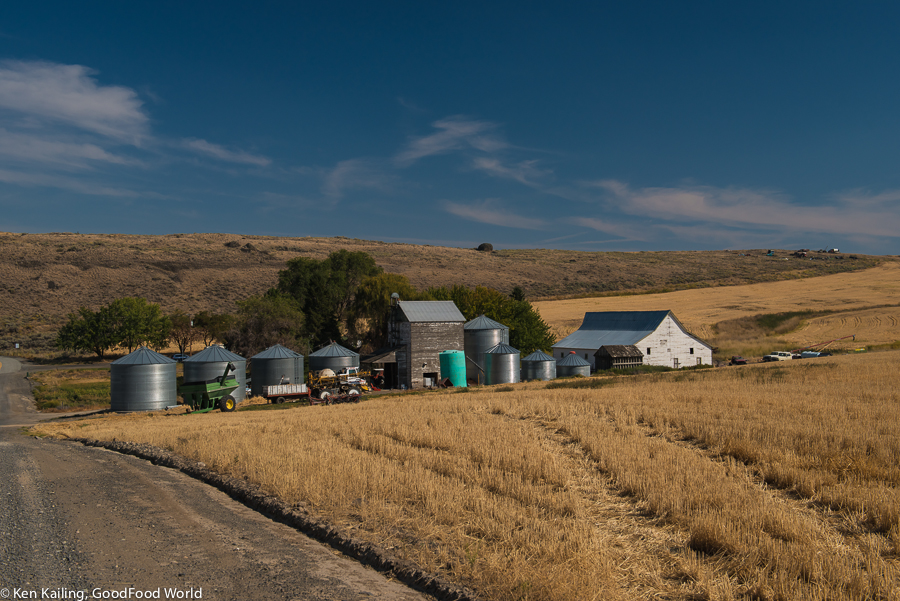
Our “National Hymn,” America the Beautiful, opens with the image of endless skies over fields of ripe golden grain that reach to purple mountains on the horizon.
Poet Katharine Lee Bates would probably be appalled to realize that she was eulogizing one of the worst examples of mono-cropping in existence – second only to the carpeting of Iowa with corn.
Her idyllic scene represents thousands of years of human development beginning with the gathering and consumption of grass seeds in the Fertile Crescent 17,000 or more years ago.
However mono-cropping of wheat has been one of the major contributors to decades of soil and water erosion and water contamination. It was also a contributor to one of the greatest environmental disasters of the Twentieth Century: the Dust Bowl of the 1930s.
And, “cereal grains” are covering the earth. Wheat – a domesticated grass – is second only to rice as the largest source of vegetable protein for human consumption. Maize (corn) is a close third.
From The Source
The first domesticated food crops – the so-called “Neolithic founder crops” – include einkorn and emmer (two of the earliest domesticated wheats), barley, lentils, peas and chickpeas, and flax. Early bread wheat containing enough gluten for yeasted bread dates from 1350 BC in Greek Macedonia.
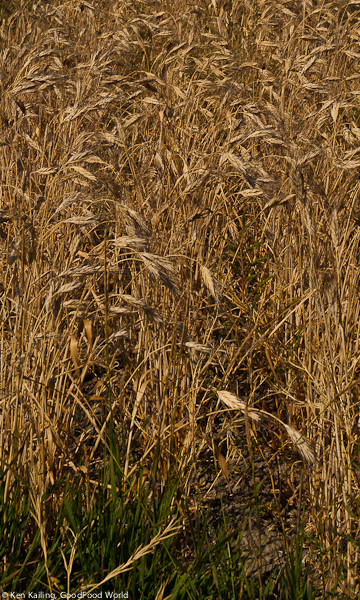
The “family tree” of the genus Triticum (wheat) is divided genetically into three groups:
- Wild and cultivated einkorn (Diploids whose genes contain 14 chromosomes): considered to be the “parent” wheat and grown by man as early as 10,000 to 12,000 years ago.
- Wild and cultivated emmer and durum wheat (Haploids – the 28 chromosome group). Durum, the world’s second most widely cultivated wheat, is primarily used to make pasta.
- Spelt and all bread wheat (Hexaploids – the 42 chromosome group). Spelt is a hulled wheat – the hulls are tightly clasped around the grain and must be removed for consumption – and common wheat is “free threshing,” that is, the hulls fall off at maturity. All hexaploid grains are domesticated; none have been found growing in the wild.
The way we use wheat is based on the amount of protein and gluten in the wheat. Pastry flour (from Soft Red or Soft White Wheat) contains weaker gluten and is good for cookies, piecrust, cakes, and other baked goods.
On the other hand, it takes a high-gluten flour to make bread that rises well and holds its shape. Bread flour comes from Hard Red or Hard White Wheat. Durum Wheat, high in protein and low in gluten, is “pasta wheat” used to make semolina flour.
Constantly Changing Grain
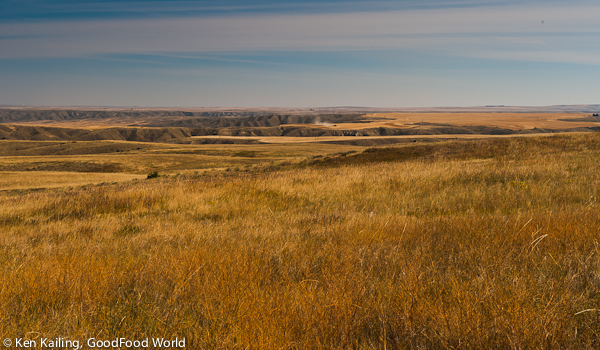
The discovery of free threshing wheat simplified the preparation and consumption of wheat and the fact that wheat “self pollinates” made it possible for early farmers to begin selecting seed for planting from the plants that matured the earliest or bore the most and largest grains.
Wheat came to America in the 16th century and thousands of landraces were developed to match the grain to the local climate and growing conditions, exploding the number of wheat varieties to more than 40,000 varieties currently identified by grain breeders.
Wild and domestic grasses were crossed with domestic wheat to create new varieties such as Triticale (pronounced (trĭ tĭ cā’ lē), a cross between wheat and rye. In contrast, chemical or mechanical processes are now used to create new varieties never found in the wild, replicating the accidental crossing that resulted in today’s bread wheat.
Local and Regional Grains
We grow a lot of wheat in Washington! The good news is that Eastern Washington is perfect wheat-growing country. Between 1850 and 1950 at least 169 different wheat varieties were grown in Washington State.
The bad news: soft white wheat – unsuitable for bread, but perfect for cakes, cookies, and other high calorie baked goods – comprises about 90% of the wheat grown here. Bad news #2: 85% to 90% of that wheat is exported. Bad news #3: We import it back in the form of mixes, doughs, and prepared foods.
In 2007 (the most recent data available from the USDA), the US imported more than $3.6 billion worth of processed cereal grain products from Canada, Mexico, Italy, China, and Japan. There is something seriously wrong with this picture!
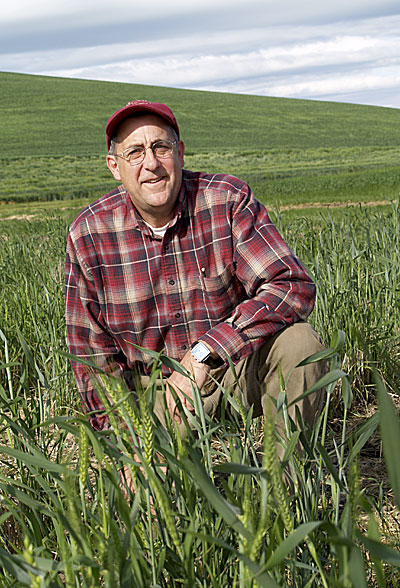
Creative small growers are doing something about it! Farmers are experimenting with local landraces and locally developed varieties in New York, California, and the Pacific Northwest. Combining grain with vegetable and fruit crops on diversified farms brings back some of the beauty and uniqueness to family farm landscapes.
Dr. Steven Jones, at Washington State University’s Mount Vernon Northwest Research and Extension Center, focuses on finding red wheat that will thrive on the wetter west side of Washington. Rather than breeding solely for more tons per acre, he is also breeding for flavor. And he is finding that as an added bonus, organic red wheat grown on the Olympic Peninsula is coming in with higher protein levels than expected. Perfect for artisan bread!
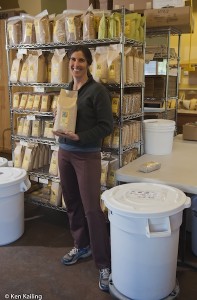
On the east side of the Cascades, Sam Lucy, grain farmer and land conservationist in the Methow Valley of north central Washington, is a one-man search and rescue team for farmland.
He has spent the last 15 years seeking out and reclaiming fallow farmland and bringing it back to viable production or transitioning it into native grasses and other plants.
Today, Sam leases and farms about 200 acres for Bluebird Grain Farms, half of which is in grain production each year growing hard red and pastry wheat as well as emmer, rye, and flax. The organic farming practices he uses require crop rotation to preserve soil fertility, and he alternates cereal grains with other grasses and plants like mustard and vetch.
At Bluebird, the Lucys not only plant and grow organic grain; they reap, thresh, mill, package, and sell it.
East Into Montana: Grain Farmers
Bob Quinn, owner/operator of Quinn Farm and Ranch, and founder of Kamut International marketer of KAMUT® brand khorasan wheat, farms along the “Hi-Line” in north-central Montana, just out of Big Sandy. It’s a part of the world that is cold – down to -40° in the winter – and dry – 12”-14” of rain annually, most of which falls in May and June.
Quinn’s 3600 acres are certified organic, and it is organic farming that makes dryland farming successful. Organic rotation focuses on cover crops and green manures that are crucial to moisture retention, soil fertility, and weed management.
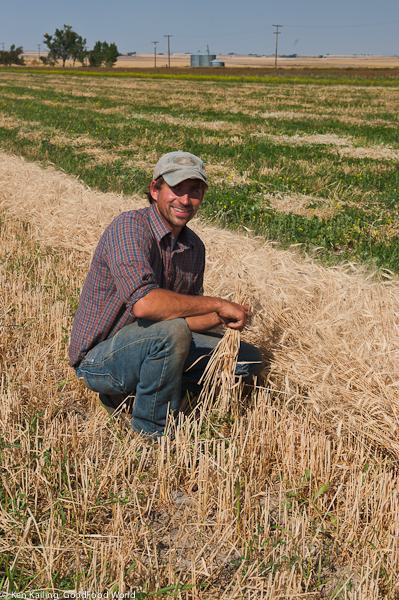
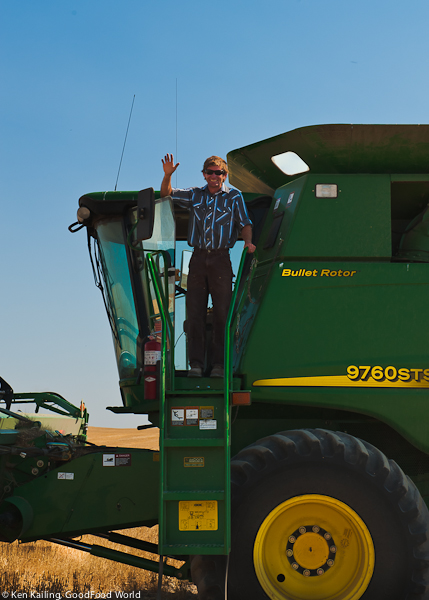
Mentoring other young farmers is also part of Bob’s farming principles and he has been a strong influence on many.
Casey Bailey raises organic KAMUT, winter wheat, and hull-less barley on his 1600 acres that lie alongside 3000 acres belonging to his father. He is slowly converting those rolling hills outside of Fort Benton MT to organic crops.
Jacob Cowgill, Prairie Heritage Farm, Conrad MT, who was at one time one of Bob Quinn’s assistants, also grows a variety of grains and legumes in an organic rotation. Jacob has farmed on his own for only a few years, yet he is continually using Quinn’s methods to experiment with a wide diversity of crops.
In 2010, members of the Cowgill’s grain and seed CSA received a total of 87 pounds of Crimson lentils, Red Chief lentils, Sonora spring wheat, KAMUT Khorasan wheat, Lucile emmer, Bronze barley, and milk thistle. Jacob’s wife Courtney also made whole wheat sourdough bread out of the Sonora spring wheat weekly for 10 families.
In the Drylands
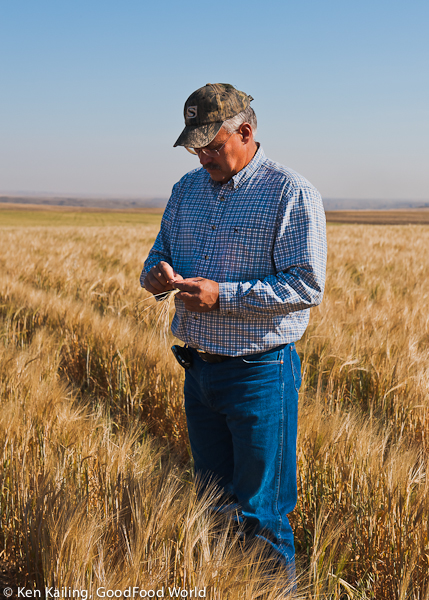
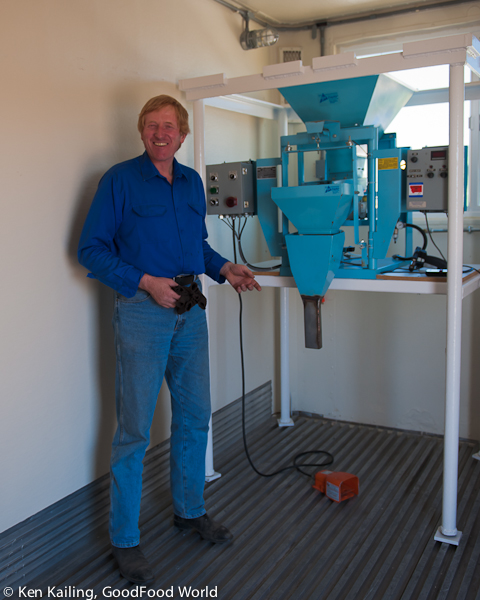
Daryl Lasilla and his wife, Linda, own Daryl Lasilla Organic Farms just outside Great Falls MT on about 1000 acres. The soil here is rich, black, and heavy with clay and the topsoil is nearly 100 feet deep in places. Daryl raises organic buckwheat, winter wheat and spelt. His spelt crop was so successful – chest high under extremely difficult conditions – that neighbors farming conventionally asked for Daryl’s advice.
In 2011, the vagaries of weather brought a long cool wet spring that delayed planting and germination by nearly a month. Once the seeds were in the ground, the rain simply stopped and for the next three months none fell. The growing season ranges from 100 to 120 days – just enough to get a crop in if the weather cooperates.
While organic grain crops may not be as successful as conventional crops during the good years, they nearly match production during average years, and exceed production during the poor years.
More than 100 miles to the east in Lewistown MT, Ole Norgaard, North Frontier Farms, faced the same weather challenges in a part of the state that has very thin, alkali soil. Ole harvested a good crop of triticale in 2011 but his specialty, black corn, came a cropper.
The cool wet spring and summer drought brought his corn to a halt. Plants that would have borne 10- or 12-inch cobs full of jet-black kernels in a good year, produced nubbins no more than 5 or 6 inches long.
From Grain to Flour
Most of the millions and millions of pounds of wheat that is not exported whole from North America is milled into flour. Thousands of years ago, women (and some men) crushed wheat and other grain between stones to make flour. It was a slow process that resulted in rough whole grain flour.
Those simple milling stones have evolved into a complex set of machinery that very efficiently turns a nutrient-rich food into a fine powder from which more than 30 essential nutrients have been eliminated. Modern milling removes as much as 30% of the original grain – the outer protective coat, the highly nutritional bran layer, and the wheat germ.
By the 1940s, as a result of these processes, malnutrition became so evident in the US that government-sponsored programs were instituted to prevent the high incidence of diseases such as Beriberi and Pellagra. Bread manufacturers began adding vitamins and minerals (primarily niacin, riboflavin, thiamin, and folic acid) back into the baking process. Today white flour is “enriched” with these four nutrients to return the flour to a somewhat nutritious state.
Where does the miller or baker get the replacement vitamins and minerals that once arrived free with the wheat berry? He buys them from big pharmaceutical companies and mixes prescribed amounts into the freshly ground flour.
Where Have All The Millers Gone?
Thorp Historic Grist Mill, Thorp WA
As part of his effort to re-establish wheat in Western Washington, Dr. Jones surveyed 73 commercial bakers in the region, and found a potential market for up to 3.5 million pounds of locally grown wheat per year.
But where to get that wheat milled? Unfortunately as the amount of wheat exported grew over the years, the network of local and regional mills that existed 150 years ago virtually disappeared. Jones is now looking for ways to connect buyers and sellers in a new network.
In 1870, there were more than 22,500 “grist” mills in the US, many of them water powered. A grist is the amount of grain brought by a farmer to the mill in a single wagon. Today there are only about 200 flourmills spread across the entire country, most in the eastern half. Cargill, ADM (Archer Daniels Midland), and ConAgra alone control more than half of all milling capacity in the US.
In Washington, the situation is similarly dire. At one time there were as many as 160 four mills located in the state. Today the number can be counted on two hands with fingers left over. There are three large commercial mills owned by ADM and PFM (Pendleton Flour Mills) processing wheat and other grains grown on Washington farms and ranches consisting of 1000s of acres.
Farmers that have wheat fields of 100 or 200 acres – or less – are too small to work efficiently with these large millers. What are the alternatives for small growers in the region?
Small farmers can “mill your own.” Bluebird Grain Farms, grows, cleans, mills, and packages emmer, red and white hard wheat berries, and dark rye flours. Brooke and Sam Lucy offer grain products “from plow to plate” – entirely processed in their own facilities.
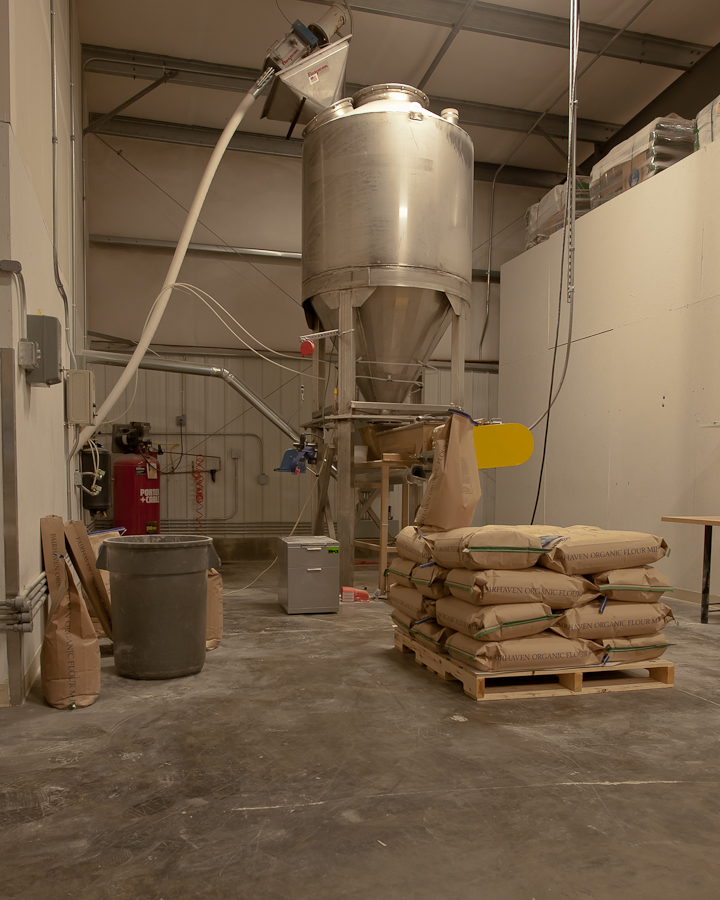
Or they can contract with a small regional mill. At present, there are two small commercial mills in operation: Fairhaven Organic Flour Mill, Burlington WA, and Camas Country Mill, Eugene OR. The distribution reach for each of these mills is limited almost entirely to Washington and Oregon.
Founded as a cooperative in 1974, Fairhaven Organic Flour Mill, was owned and run by a handful of worker-shareholders. By the end of the 1980s only two remained. Bill Distler bought out his partner and ran the mill for nearly 20 years.
In 2007, Kevin Christenson purchased the mill and in the fall of 2010, after more than 36 years in Bellingham, Fairhaven moved to a 7,500 square foot space in Burlington. The mill buys grain and mills flour under its own label and offers custom milling services for growers with smaller amounts of grain.
At least 60% of the grain Fairhaven mills is grown in Washington and 50% of the wheat is from Washington.
Kitchen-Sized Flour Mills For Sale
More home cooks and bakers are preparing their own food and baking bread is becoming more commonplace. The availability of grain “berries” – seeds – is expanding and home bakers are looking to mill their own flour for freshness and flavor.
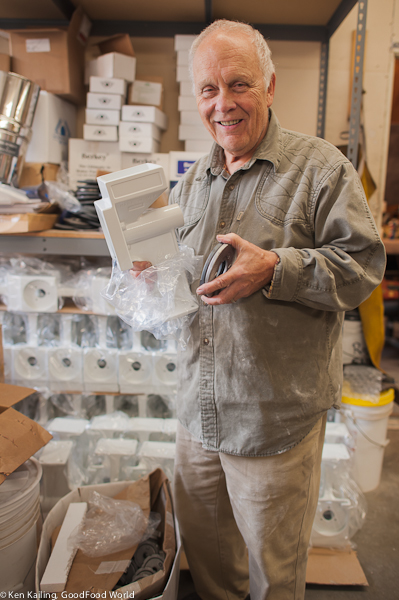
For nearly 40 years, Jack Jenkins has manufactured and marketed Country Living Grain Mills that are hand-powered, bike-powered, horse-powered, wind-powered, water-powered, and even machine-powered! And he sells them around the world.
Jack has also built a thriving local food economy! Here’s what Jack’s supply chain looks like:
- The body of the mill is cast from recycled aircraft aluminum in Ferndale, WA (50 miles).
- The white food-grade powder coating is applied near Marysville, WA (20 miles).
- A foundry that casts some of the parts for the mill is also in Marysville.
- The grinding plates are cast in Spokane, WA (300 miles).
- The plates are further machined near Arlington, WA (15 miles).
- The packaging is manufactured in Seattle, WA (55 miles).
- All assembly is done in a shop located next to the house in which Jack lives (0 miles).
Buy a bag of organic wheat berries from Kevin Christenson at Fairhaven Organic Grain Mill (18 miles), where most of the wheat is grown by Washington farmers, and you have a functioning local food economy!
Our Daily Bread
Humanity has been making and eating bread – at first unleavened and then later leavened with a variety of yeasts – for thousands of years. And bread was truly the “staff of life” for centuries. In the Middle Ages (the 5th through the 15th centuries), a majority of the population ate 2 to 3 pounds of bread a day.
Peasants ate heavy dark breads and the wealthy preferred bread made from white flour. The whiteness of the flour and the bread made from it were a sign of high social status because it was scarce and expensive.
As the quality and variety of foods improved and other sources of protein became available, the amount of bread consumed began to drop. By 1880, daily diets included only about 1 1/3 pounds of bread and, just a century later, in 1977, that amount dropped to a little over 6 ounces of bread a day. Today, even with government recommendations of 6 to 8 ounces of “grain equivalents” a day, most Americans are likely eating half as much bread every day as they did just 35 years ago.
As early as the mid-19th century, bakers were attempting to speed up the production of bread. Even the fastest traditional methods could take up to 24 hours to produce a finished loaf.
The Aerated Bread Company, London, perfected a method of combining flour and water supersaturated with carbon dioxide under pressure and commercialized the process in the late 1800s. When thoroughly mixed, the spongy dough was ready for the oven. No yeast and no time needed for the yeast to ferment. While the entire process took less than 30 minutes, it was never adopted in the US.
By the early 1950s, American plant bakeries were mass-producing bread and bakers discovered that the addition of certain chemicals and enzymes – bread “improvers” – to the dough could shorten the process to two hours. Bread improvers boosted the amount of amylase and protease enzymes that develop the flavor and strengthen the gluten artificially, giving the bread a better structure and retaining more of the gas produced by the yeast.
In the UK in 1961, another major “advance” in commercial bread making – reducing production time to about 3 1/2 hours – happened with the development of the Chorleywood Bread Process, which incorporates intense mechanical working of the dough to again reduce the fermentation time. The process of high-energy mixing means allows the use of lower quality grain, and is used around the world in large bread “factories,” though not as much in the US as in other countries.
By the early 70s, as the natural food movements and the “second wave” of food co-ops spread beyond the back-to-the-earth idealists, consumers began to look for healthier and safer foods.
In response to mass-produced soft, damp, nutritionally deficient chemical-laced bread, a demand – “craze” some would say – for artisan, home-style breads started in the 1990s. And by 2005, even makers of refined white bread began to add brown coloring (caramel) and cellulose (wood fiber) to give the appearance of whole-wheat, high-fiber bread. In 2006, Wonder Bread was one of the first brands to introduce whole grain white breads made with an albino wheat variety of wheat, that doesn’t have the “harsh taste” of whole red-wheat flour.
Today we are seeing even small “look-natural” bakeries making imitation artisan and sourdough bread by using chemical additives in prepared mixes which contain most or all of the dough’s ingredients.
Tall Grass Bakery
Tall Grass Bakery, Seattle WA
Amanda Irving and René Featherstone are an unlikely partnership and yet it takes both – the farmer and the baker – to turn an ancient grain like spelt into delicious bread.
Spelt, emmer, and einkorn are grown in eastern Washington on Lentz Farms by René Featherstone and Lena Lentz Hardt. Established in 1898, Lentz Farms grew wheat and barley for more than 100 years. And like most farms raising wheat, Lena and René were challenged with wheat prices that rose and fell on the commodities markets.
In the late 1990s, René and Lena decided to experiment with ancient. By planting and replanting, removing rogue plants, and fighting off hungry birds, René was able to finally grow enough grain to harvest one small field mechanically. It only took him 8 years to do it!
Today – more than a dozen years later – Lentz Farms sells 90% of the spelt they raise to Bob’s Red Mill, Milwaukie OR. Small artisan bakers like Amanda’s Tall Grass Bakery or specialty retailers like Chefshop.com also buy small quantities of spelt and emmer from René and Lena.
At Tall Grass, Amanda makes primarily naturally leavened breads using a living culture of flour, water and natural yeast that many people would refer to as “sourdough starter,” but she calls “levain” – French for “leaven” or “to rise.”
She takes the flour from those ancient grains and combines it with water, salt, and the slightly fermented starter to make delicious and nutritious breads.
Essential Baking

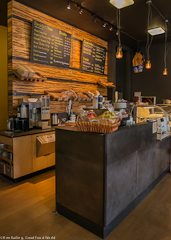
When he was a child, George DePasquale’s quintessential (and large!) Italian-American family gathered every weekend to make food for the coming week – for the whole family. Fresh pasta hung drying over the backs of the sofa and chairs and lay curled on the beds, pots of sauces simmered on the stove, and piles of fresh fish were cleaned and frozen. And Mama always baked bread for the family.
It was the homemade bread and exposure to the bakery down the street that made those years so important to George. He literally grew up with “flour in his hair;” baking bread all his life.
Today at Essential Baking, George is experimenting with locally grown and milled wheat. And he has discovered that he has become an unwitting advocate for the terroir of wheat. “I don’t know how that happened. The wheat being grown in western Washington seems to have way more flavor than other wheat,” says George. “I believe that there is a certain ‘localness’ to flavor. Unfortunately large growers target varieties of wheat for high production and ease of processing rather than taste.”
Tastin’ Bread!
Let’s try a taste experiment! This will require a little shopping…
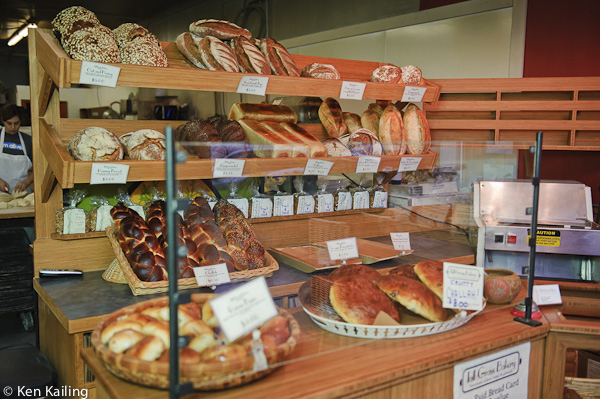
We want to compare white “supermarket” bread, “whole grain” commercial bread, a “pseudo-artisan” bakery bread, and a locally-produced true artisan bread from a bakery like Tall Grass Bakery or Essential Baking. Make your selections and let’s go!
Compare the weight, the color, the texture, and most of all – the flavor. What do you find? The supermarket brands are most likely damp, floppy, and flavorless.
Why? Conventional plant breeders are constantly seeking genetic traits that result in higher and higher yields, however they seem to have left out a key quality measure: flavor.
When commercial supermarket bread includes high fructose corn syrup, salt, soybean oil, and sugar as standard ingredients (just read your nutrition labels), the flavor of the flour used in baking is not as important.
Much like wine and cheese, the flavors of grain – and the breads made from them – can be unique to a region or even a microclimate present on a group of farms. Small grain growers in Washington are experimenting with heirloom varieties. The grains and flours are sold locally to emphasize the concept of terroir: unique flavors developed from local soils and growing conditions.
Taking Back Our Bread
People who seek out good food are willing to pay $40 for a bottle of imported olive oil and $25 a pound for farmstead cheese, but will balk at paying $6 or $7 for a loaf of bread. After all, it’s just flour and water… Artisan bakers – home bakers, small bakeries like Tall Grass, and larger bakeries like Essential Baking – are all educating consumers about the value of good grain, good production, and quality bread.
It is not enough to have farmers growing grain as part of their crop rotation or to have artisan bakers turning out dense, nutrient-rich breads, but we have to bring back the skilled millers who grind the grain to flour. By reconnecting the broken links between local and regional grain farmers, the grain cleaners, and millers who process their harvest, and the home and commercial bakers who make it into loaves, we can take back our daily bread.
Eat whole grains and artisan bread. Seek out small local and regional grain growers. Buy a small mill and grind your own. Celebrate the terroir of your daily bread!
Marie Antoinette may – or may not – have said, “Let them eat cake!” when bread riots broke out in France in the late 18th century and launched the French Revolution. A new revolution needs to happen.
Today’s consumers are happily eating fluffy, enriched, cake-like white bread. It’s time to say, “Let them eat bread, real bread!”
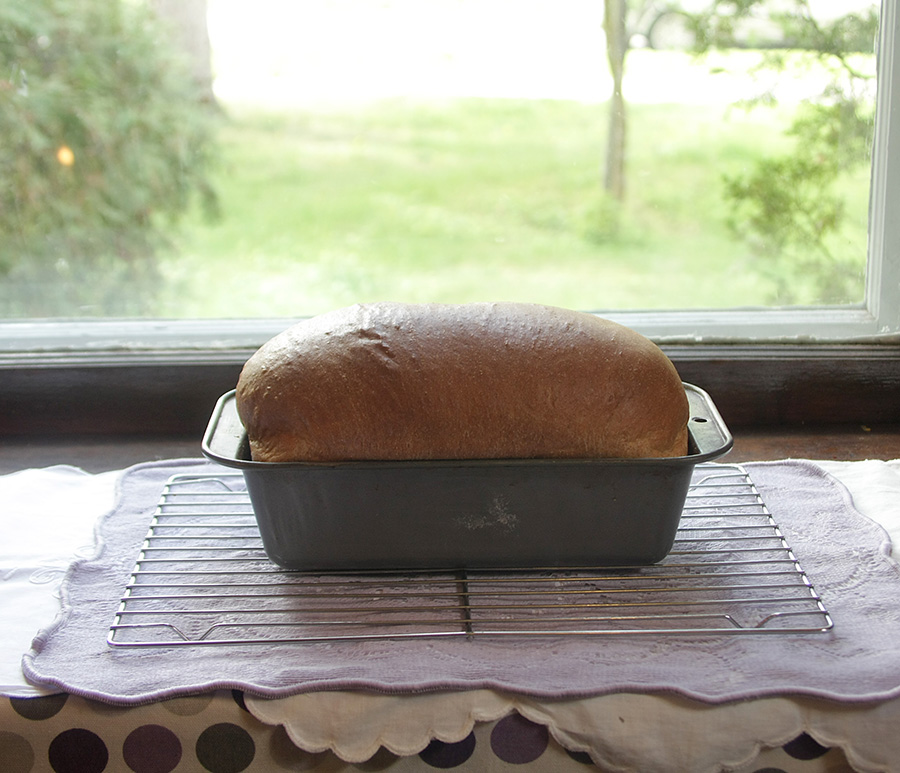
____________________________________________
Read More
Reclaiming Farmland and an Ancient Grain
On the Road: Emmer – An Ancient Grain
Dryland Farmers – Eastern Washington and Northwestern Montana
How to Buy a Flour Mill: Check Craig’s List
On the Road: Historic Grist Mill, Thorp WA
Country Living Grain Mills: One Small Company’s Local Food Economy
When Did our Daily Bread Take a Wrong Turn?
Tall Grass Bakery: Let Them Eat Bread

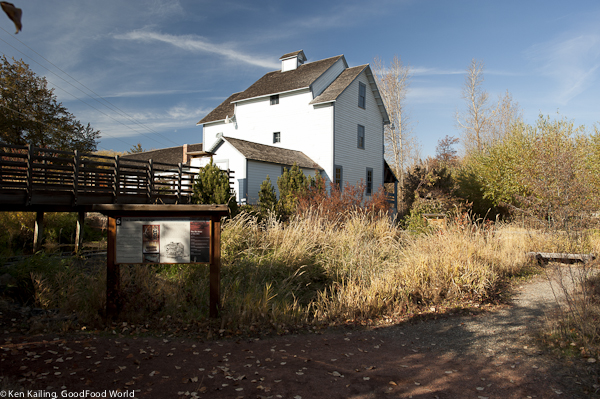
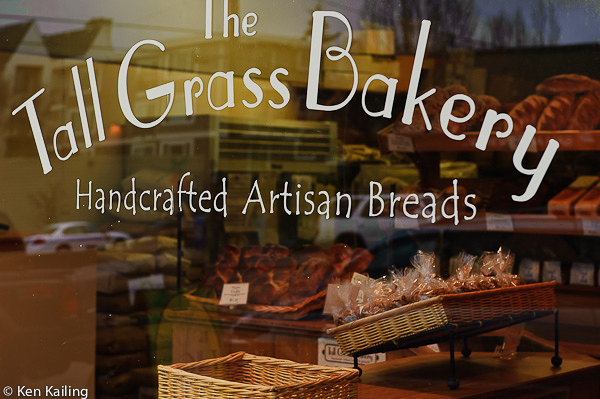
I would like to know if you sell and ship to spokane wa address? No one in town or around i can find makes naturally leavened whole grain breads the bakerys i’ve found and contacted are midwest and they will not ship this far? Isn’t that something? I follow the weston price foundations cooking methods nourishing traditions by sally fallon, this is how i’ve learned the diff from yeasted breads to naturally leavened and for organic flours used they are always white/unbleached (i have been buying trader joes) and using sparingly since there’s no phytic acid in it but also not much nutrition either would love to find a artesean bakery in my area but so far all use conventional wheats (I don’t want to eat pesticides); so any thoughts? let me know thanks.
Susan,
I’m sorry, I don’t have a bakery, but I can recommend two bakeries you might try in Spokane:
Bouzies Bakery (http://www.bouziesbakery.com/)
Petit Chat Village Bakery (https://www.facebook.com/petitchatvillagebakery)
It took me a few days to find someone in Spokane who could help out, but these both look like you could find good breads on their shelves.
Good luck!
Gail N-K
Co-Publisher
Great post — packed with information. Thanks very much for the photos and the well-done discussion of the process from field to table, plow to plate. I had never heard of the Aerated Bread Company, and you have a great deal of other interesting data. I’ll be back.
Teri,
We have met so many wonderful people in the “field to table” value chain; people that get overlooked in the grand scheme of things.
In a world where wheat is grown on 10s of 1000s of acres at a time, grain is milled by the train car load, and the amount of bread made is measured by the number of tons of dough produced a day, the small growers, millers, and bakers need, even more, to be recognized!
Much appreciate the kind words!
Gail N-K
GoodFood World